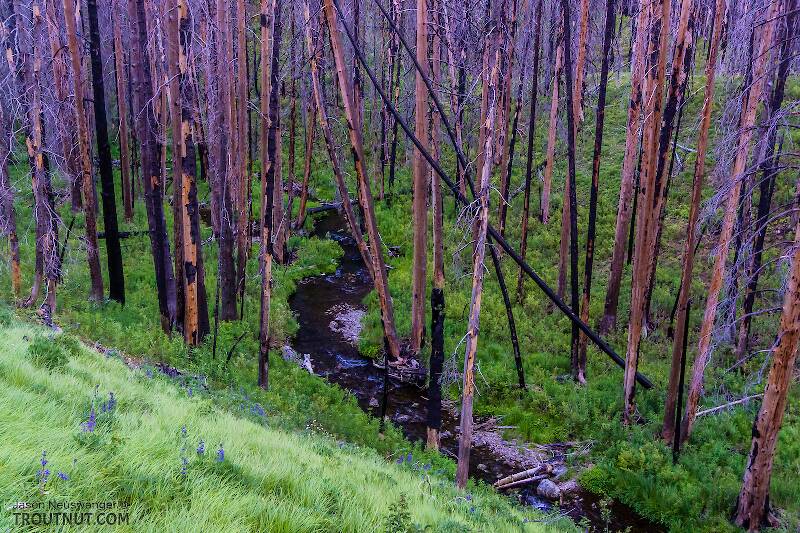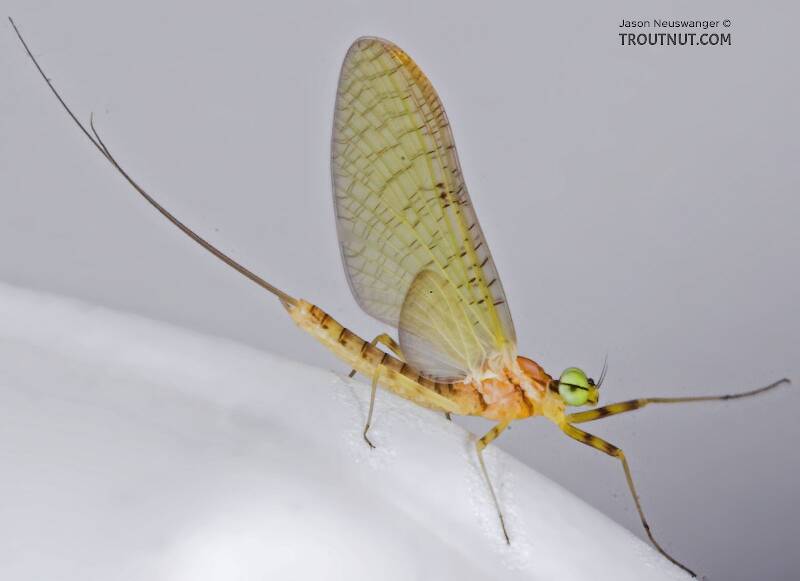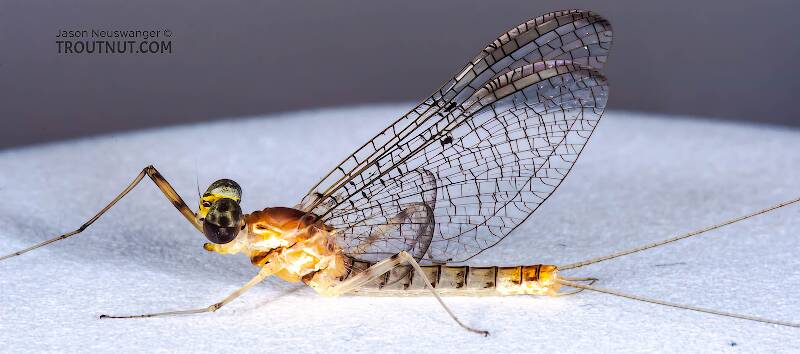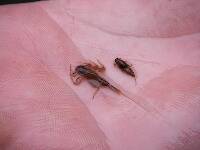
Blue-winged Olives
Baetis
Tiny Baetis mayflies are perhaps the most commonly encountered and imitated by anglers on all American trout streams due to their great abundance, widespread distribution, and trout-friendly emergence habits.
Featured on the forum

Troutnut is a project started in 2003 by salmonid ecologist Jason "Troutnut" Neuswanger to help anglers and
fly tyers unabashedly embrace the entomological side of the sport. Learn more about Troutnut or
support the project for an enhanced experience here.
This topic is about the Mayfly Genus Stenacron
The species in this genus were formerly classified in Stenonema. See the genus Maccaffertium for details. Only one species, Stenacron interpunctatum, is important to fly fishermen. See its page for details.Example specimens
LittleJ on Nov 25, 2006November 25th, 2006, 3:24 pm EST
Jason
I know I'm a little out of season, butI was curious if you had any shots of Stenacron Interpunctatum next to your hook quide, or could just give me a size range. I was thinking they were 14-16 but could be wrong. Also you have written that Stenacron Interpunctatum were rarely called cahills. If so what mayfly is it that i'm after (that is common name "cahill"). The stenacron look the same to me, but i have also never kept and memorized any specimens.
Thanks
Jeff
I know I'm a little out of season, butI was curious if you had any shots of Stenacron Interpunctatum next to your hook quide, or could just give me a size range. I was thinking they were 14-16 but could be wrong. Also you have written that Stenacron Interpunctatum were rarely called cahills. If so what mayfly is it that i'm after (that is common name "cahill"). The stenacron look the same to me, but i have also never kept and memorized any specimens.
Thanks
Jeff
GONZO on Nov 26, 2006November 26th, 2006, 3:10 am EST
Hi Jeff,
S. interpunctatum is typically in the 9-12mm size range, or about #12-14. Many Maccaffertium and Stenacron species are loosely referred to as "cahills" (light cahills, yellow cahills, cream cahills, chalk cahills, etc.), but this name derives from a fly pattern and has no specific meaning. Pink cahill, pink lady, and salmon spinner are also names sometimes used for the female interpunctatum duns and spinners. (In older texts, current Maccaffertium and Stenacron species are listed as Stenonema. S. interpunctatum often appears as Stenonema canadensis, heterotarsale, or canadense [sic].)
If you click on the name Stenacron interpunctatum in the Stenacron(Heptageniidae) page, you'll find that the first specimen is photographed next to the size scale. It is 9-10mm--as Jason indicates, somewhat small for this species.
S. interpunctatum is typically in the 9-12mm size range, or about #12-14. Many Maccaffertium and Stenacron species are loosely referred to as "cahills" (light cahills, yellow cahills, cream cahills, chalk cahills, etc.), but this name derives from a fly pattern and has no specific meaning. Pink cahill, pink lady, and salmon spinner are also names sometimes used for the female interpunctatum duns and spinners. (In older texts, current Maccaffertium and Stenacron species are listed as Stenonema. S. interpunctatum often appears as Stenonema canadensis, heterotarsale, or canadense [sic].)
If you click on the name Stenacron interpunctatum in the Stenacron(Heptageniidae) page, you'll find that the first specimen is photographed next to the size scale. It is 9-10mm--as Jason indicates, somewhat small for this species.
Troutnut on Nov 26, 2006November 26th, 2006, 3:32 am EST
Gonzo hit it right on the mark.
The only thing I would add is that others in the Heptageniidae family (from the genera Heptagenia, Nixe, and Leucrocuta, at least) are also called Cahills sometimes.
Don't take it too literally that my site says they're "rarely" called cahills. That's got a bit to do with a technicality in the way the site is programmed; if I attach a common name to the family level and all species beneath it, which I may have done here, then I usually set it to one of the lowest priorities (like "rarely") so that genus-specific or species-specific common names can easily override it even if they're only used occasionally too. They're probably quite often called cahills, but I would discourage people from using that term instead of something a little more specific.
The only thing I would add is that others in the Heptageniidae family (from the genera Heptagenia, Nixe, and Leucrocuta, at least) are also called Cahills sometimes.
Don't take it too literally that my site says they're "rarely" called cahills. That's got a bit to do with a technicality in the way the site is programmed; if I attach a common name to the family level and all species beneath it, which I may have done here, then I usually set it to one of the lowest priorities (like "rarely") so that genus-specific or species-specific common names can easily override it even if they're only used occasionally too. They're probably quite often called cahills, but I would discourage people from using that term instead of something a little more specific.
Jason Neuswanger, Ph.D.
Troutnut and salmonid ecologist
Troutnut and salmonid ecologist
GONZO on Nov 26, 2006November 26th, 2006, 4:44 am EST
Hi Jason--didn't know you were "home." I just wanted to add a further clarification about the problem of common names. There is a difference between the common names used in most angling literature and the common names used in scientific literature. In angling literature (particularly with regard to mayflies), common names simply refer to regional or local nicknames frequently used by anglers. In scientific literature, common names usually undergo a more formal process of acceptance.
For example, if you look up the large white egret that is frequently found wading the Breeches in my neighborhood, you'll currently find Casmerodius albus listed as the "Great Egret." My copy of Audubon's Field Guide to North American Birds contains this note: "Formerly known as the 'American Egret,' 'Common Egret,' 'Large Egret, 'White Egret,' 'Great White Egret,' and 'Great White Heron,' its official name in North America is now Great Egret." Notice the use of the word "official"--meaning that some consensus has been reached within the scientific community.
With mayflies, no such consensus has been established (or attempted, as far as I know). In contrast, Stark, et al. have created a list of common names for stoneflies (for US and Canada, 1998). While these names have yet to become well-established in angling literature, they are generally accepted by the scientific community. Hope this helps to shed some additional light on this perplexing problem.
For example, if you look up the large white egret that is frequently found wading the Breeches in my neighborhood, you'll currently find Casmerodius albus listed as the "Great Egret." My copy of Audubon's Field Guide to North American Birds contains this note: "Formerly known as the 'American Egret,' 'Common Egret,' 'Large Egret, 'White Egret,' 'Great White Egret,' and 'Great White Heron,' its official name in North America is now Great Egret." Notice the use of the word "official"--meaning that some consensus has been reached within the scientific community.
With mayflies, no such consensus has been established (or attempted, as far as I know). In contrast, Stark, et al. have created a list of common names for stoneflies (for US and Canada, 1998). While these names have yet to become well-established in angling literature, they are generally accepted by the scientific community. Hope this helps to shed some additional light on this perplexing problem.
LittleJ on Nov 27, 2006November 27th, 2006, 7:02 am EST
Thanks guys, If it not for sites like this I would be in trouble. I have no idea how you guys retain all this info!
Thanks
Jeff
Thanks
Jeff
GONZO on Nov 27, 2006November 27th, 2006, 10:39 am EST
Jeff,
Retaining "all this info" is the easy part. The hard part is finding a use for these arcane bits of trivia. Without someone who is interested enough to ask the questions, it's probably just a waste of brain space!!! :)
Retaining "all this info" is the easy part. The hard part is finding a use for these arcane bits of trivia. Without someone who is interested enough to ask the questions, it's probably just a waste of brain space!!! :)
Troutnut on Nov 27, 2006November 27th, 2006, 5:59 pm EST
You'll retain the important parts when you're out on the stream and something clicks and you go, "oh, yeah! That's what they were talking about." It may not happen very often... but many parts aren't all that important. :)
Jason Neuswanger, Ph.D.
Troutnut and salmonid ecologist
Troutnut and salmonid ecologist
Martinlf on Dec 1, 2006December 1st, 2006, 6:56 am EST
I haven't figured out how you do that nifty quote from a previous post and reply, so I've cut and pasted in previous comments:
"Also you have written that Stenacron Interpunctatum were rarely called cahills." --Little J (Jeff)
"Don't take it too literally that my site says they're "rarely" called cahills. That's got a bit to do with a technicality in the way the site is programmed; if I attach a common name to the family level and all species beneath it, which I may have done here, then I usually set it to one of the lowest priorities (like "rarely") so that genus-specific or species-specific common names can easily override it even if they're only used occasionally too. They're probably quite often called cahills, but I would discourage people from using that term instead of something a little more specific." --Jason
Jason, since you have called for suggestions for the site and we have discussed making it both appealing to specialists and generalists, I'll make the following suggestion, knowing that it may be impossible, and/or not the best use of your time.
If there is a way to change "rarelly called" to "sometimes called," it might help someone in the future who doesn't see this thread. I had the same question Jeff raised once when I was browsing.
I realize that the common names issue is an ugly bucket of worms, but it may help some of us who are still struggling to learn the Latin names to relate them to what we typically hear on the streams and in the shops. As much information as is feasible connecting the scientific to the common names and patterns would be welcome, along with some caveats about the confusing use of the same common names for very different bugs.
I'd also like to second Jeff's awe at how much some of you folks know, and Jason's observation about how bits of knowledge can at times, click in on the stream and provide satisfaction--and sometimes more fish.
"Also you have written that Stenacron Interpunctatum were rarely called cahills." --Little J (Jeff)
"Don't take it too literally that my site says they're "rarely" called cahills. That's got a bit to do with a technicality in the way the site is programmed; if I attach a common name to the family level and all species beneath it, which I may have done here, then I usually set it to one of the lowest priorities (like "rarely") so that genus-specific or species-specific common names can easily override it even if they're only used occasionally too. They're probably quite often called cahills, but I would discourage people from using that term instead of something a little more specific." --Jason
Jason, since you have called for suggestions for the site and we have discussed making it both appealing to specialists and generalists, I'll make the following suggestion, knowing that it may be impossible, and/or not the best use of your time.
If there is a way to change "rarelly called" to "sometimes called," it might help someone in the future who doesn't see this thread. I had the same question Jeff raised once when I was browsing.
I realize that the common names issue is an ugly bucket of worms, but it may help some of us who are still struggling to learn the Latin names to relate them to what we typically hear on the streams and in the shops. As much information as is feasible connecting the scientific to the common names and patterns would be welcome, along with some caveats about the confusing use of the same common names for very different bugs.
I'd also like to second Jeff's awe at how much some of you folks know, and Jason's observation about how bits of knowledge can at times, click in on the stream and provide satisfaction--and sometimes more fish.
"He spread them a yard and a half. 'And every one that got away is this big.'"
--Fred Chappell
--Fred Chappell
Troutnut on Dec 1, 2006December 1st, 2006, 8:04 am EST
If there is a way to change "rarelly called" to "sometimes called," it might help someone in the future who doesn't see this thread. I had the same question Jeff raised once when I was browsing.
I've got a "sometimes" level, too.
Basically, I have four levels in the database, which correspond to the number of stars next to the common names listed on a taxon's page or the taxa listed on a common name's page. (This is in the navigation part of the right column.)
The text on the common name pages is automatically generated from those ratings to say "These are ______ called ______."
Right now I fill in the first blank as follows:
1 star: "very rarely"
2 stars: "sometimes"
3 stars: "often"
4 stars: "pretty much always"
If you guys can come up with a better set of words to describe those associations I'll be happy to change it.
By the way, to do the quote thing, type in {quote}here's the stuff you quote{/quote} but use square brackets instead of curly brackets.
Jason Neuswanger, Ph.D.
Troutnut and salmonid ecologist
Troutnut and salmonid ecologist
Quick Reply
Related Discussions
Topic
Replies
Last Reply
Re: Last summer while fishing on the Henry's Fork in Idaho.....Is it Epeorus Pleuralis???
In the Identify This! Board by Byhaugh
In the Identify This! Board by Byhaugh
10
Jan 16, 2014
by Entoman
by Entoman
1
Apr 18, 2007
by Troutnut
by Troutnut
0
Oct 19, 2006
by GONZO
by GONZO
4
May 24, 2008
by Softhackle
by Softhackle








